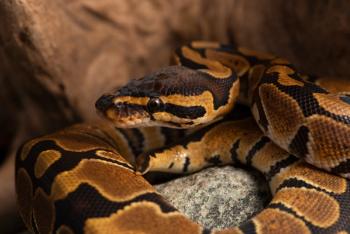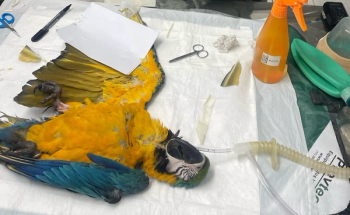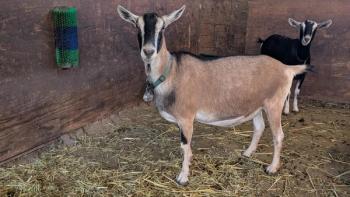
- dvm360 February 2023
- Volume 54
- Issue 2
- Pages: 20
Elective ovariectomy in guinea pigs and its role in prevention of reproductive diseases

Extending reproduction disease prevention to exotics
As veterinarians, we are constantly advocating for our patients. A large part of
our work is educating clients on the best practices to prevent diseases. We have done an excellent job advocating for dog and cat elective spays, preventing reproductive disease that would otherwise require invasive and often challenging surgeries. But are we extending the same effort to nontraditional pets?
Guinea pigs are commonly kept as pets and often present to us with preventable diseases. Among the most common diseases of guinea pigs are ovarian cysts, with the prevalence ranging from 58% to 100%.1-4 There are 2 distinct types of cysts: nonfunctional serous cysts (cystic rete ovarii), and functional hormone-producing follicular cysts. Both types of cysts can reach very large sizes, from millimeters up to 7 cm, causing visible abdomen enlargement, discomfort, pain, and secondary issues. Functional cysts can also cause the classic presentation of bilaterally symmetric nonpruritic flank alopecia and mammary hyperkeratosis.1,3,4
Tumors of the reproductive tract, although less frequent, are common (yet preventable) in guinea pigs. The incidence of uterine neoplasia and hyperplasia in guinea pigs older than 6 years has been reported at 15.6%.5 Leiomyomas and endometrial adenomas are the most common uterine tumors in guinea pigs, but other uterine tumors can also occur, such as leiomyosarcoma, endometrial adenoma, and adenocarcinoma. Interestingly, a strong correlation between the occurrence of leiomyomas and hormonally active cystic rete ovarii has been recognized. Abdominal enlargement and hemorrhagic vaginal discharge are frequent clinical signs. Ovarian tumors can also occur but are more rarely seen.1,3,5
Endometritis and pyometra are well-known diseases of small animals and can occur in breeding and nonbreeding guinea pig patients. The infections are most commonly caused by Bordatella bronchiseptica and hemolytic Streptococcus spp but Escherichia coli, Corynebacterium pyogenes, and Staphylococcus spp have also been also reported. Hemorrhagic or purulent vaginal discharge are characteristic clinical signs.1,3,6
Dystocia and pregnancy toxemia are further preventable reproductive disease in guinea pigs. The ossification of the pubic symphysis has been historically blamed as the causation of dystocia in sows bred and having their first litter after 6 months old. However, correlation was not found in a more recent study. Dystocia may be related to the large size of the pups, narrow pelvic canal, or inadequate separation of the pubic symphysis at parturition.1,3
Due to the high incidence of reproductive abnormalities in guinea pigs, clients should be educated on how to prevent these issues by electing to spay their pets at a young age. Although no comparative studies have been performed, ovariectomy (OVE) is usually recommended for sows younger than 2 years old, while ovariohysterectomy (OVH) is recommended for older females. OVH is usually performed via a ventral midline incision as described for the routine surgical approach in any patient. However, the guinea pig anatomy presents several challenges during this procedure because the voluminous gastrointestinal tract, in particular the cecum, must be manipulated to reach the dorsally positioned ovaries. In addition, the ovarian pedicle is short, and the ovarian suspensory ligament is friable and minimally distensible, making it difficult to exteriorize the ovary through a midline abdominal incision.3,7,8
In contrast, OVE can be performed via a unilateral or a bilateral flank approach, significantly diminishing the challenges, length of surgery, complications, and postoperative care of a midline laparotomy. An incision of the skin and the abdominal wall is made between the last cartilaginous ribs and the lateral processes of the lumbar vertebrae. The subcutaneous tissue and the muscular wall are then bluntly dissected with minimal hemorrhage. The ovary, the salpinges, and the proximal tract of the uterine horn are easily exposed, ligated, and resected, and a two-layer closure is performed.3,8 Worth mentioning is that OVH has been described via unilateral flank approach in guinea pigs and might be an alternative to OVH via midline laparotomy.7
In conclusion, elective ovariectomy should be the standard of care for young female guinea pigs, and clients should be educated when presenting for annual wellness examination.
Laila M. Proença MV, DVM, PhD, MS, DACZM, founder and CEO of VetAhead, has always been passionate about veterinary medicine. She is the first South American to become a diplomate of the American College of Zoological Medicine, with an emphasis on zoological companion animals. She is the coeditor of the 2015 Exotic Endoscopy issue of Veterinary Clinics of North America and has been actively participating in the zoological medicine community, leading wet labs and giving national and international lectures, courses (including on endoscopy), and master classes.
References
- Kondert L, Mayer J. Reproductive medicine in guinea pigs, chinchillas and degus. Vet Clin North Am Exot Anim Pract. 2017;20(2):609-628. doi:10.1016/j.cvex.2016.11.014
- Minarikova A, Hauptman K, Jeklova E, Knotek Z, Jekl V. Diseases in pet guinea pigs: a retrospective study in 1000 animals. Vet Rec. 2015;177(8):200. doi:10.1136/vr.103053
- Pignon C, Mayer, J. Guinea pigs. In: Quesenberry KE, Orcutt CJ, Mans C, Carpenter JW, eds. Ferrets, rabbits, and rodents: clinical medicine and surgery. 4th ed. Elsevier; 2020:270-297.
- Pilny A. Ovarian cystic disease in guinea pigs. Vet Clin North Am Exot Anim Pract. 2014;17(1):69-75. doi:10.1016/j.cvex.2013.09.003
- Rogers JB, Blumenthal HT. Studies of guinea pig tumors. I. Report of fourteen spontaneous guinea pig tumors, with a review of the literature. Cancer Res. 1960;20:191-197.
- Veiga-Parga T, La Perle KM, Newman SJ. Spontaneous reproductive pathology in female guinea pigs. J Vet Diagn Invest. 2016;28(6):656-661. doi:10.1177/1040638716665429
- Rozanska D, Rozanski P, Orzelski M, Chlebicka N, Putowska K. Unilateral flank ovariohysterectomy in guinea pigs (Cavia porcellus). N Z Vet J. 2016;64(6):360-363. doi:10.1080/00480169.2016.1207574
- Capello V. Common surgical procedures in pet rodents. J Exot Pet Med. 2011;20(4):294-307. https://doi.org/10.1053/j.jepm.2011.07.002
Articles in this issue
over 2 years ago
An inside look at our Fetch Charlotte keynote presentationsover 2 years ago
The veterinary health gapover 2 years ago
National Justice for Animals Weekover 2 years ago
Fear Free for allover 2 years ago
The receptionistover 2 years ago
The tooth, the whole tooth, and nothing but the tooth!almost 3 years ago
The latest on canine atopic dermatitisalmost 3 years ago
What to consider in difficult dental extractionsalmost 3 years ago
3 tips for marketing veterinary dental servicesNewsletter
From exam room tips to practice management insights, get trusted veterinary news delivered straight to your inbox—subscribe to dvm360.






